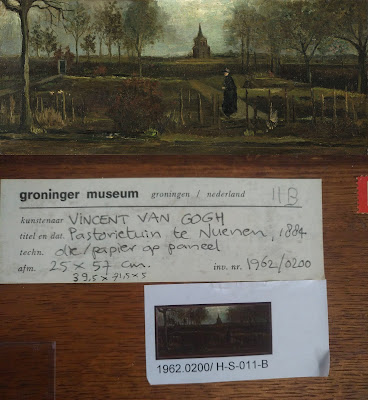 art theft,Groninger Museum,museum theft,Singer Laren Museum,stolen art database,The Netherlands,Vincent van Gogh
art theft,Groninger Museum,museum theft,Singer Laren Museum,stolen art database,The Netherlands,Vincent van Gogh
 No comments
No comments
Vincent Van Gogh's stolen painting, The Parsonage Garden at Nuenen in Spring, has been recovered.
After extensive work on the part of the Dutch National Police and a private investigator, authorities have announced that Vincent Van Gogh's “The Parsonage Garden at Nuenen in Spring” was recovered yesterday. The painting, which is part of the Groninger Museum's collection was stolen on 30 March 2020 while on loan at the Singer Laren museum for its The Mirror of the Soul exhibition. To steal the painting, police indicated that the thief accessed the museum by brazenly smashing his way in through the reinforced glass front door with a sledgehammer.
Once inside, he had obtained entry through the front door, then moved past the ticket desk and gift shop and smashed open a second locked door, cherry-picking this singular Van Gogh painting and quickly leaving the way he came in, with the artwork tucked under his right arm and carrying the sledgehammer in his left hand.
Long rumoured to be in the hands of the drug underworld, the Van Gogh painting's artnappers had previously tantalised law enforcement authorities by sending a cheeky "proof of life” photo to Arthur Brand, a private art crime investigator based in Amsterdam who's made headlines with a string of high-profile art recoveries.
The hostage-like photograph, sent to Brand on June 18, 2020 showed Vincent's painting laying flat on a garbage bag, sandwiched between a New York Times newspaper and a Dutch copy of the autobiography "The Master Thief" written by Octave "Okkie" Durham, the thief who stole two other Vincent van Gogh paintings on the evening of 7 December 2002 from the Van Gogh Museum in Amsterdam.
Later, Nils Menara, AKA Nils M., was sentenced to 8 years in prison by the Lelystad court in the Netherlands for the theft of this painting as well as the second theft of Dutch Golden Age master Frans Hals' 1626 painting Two Laughing Boys taken from the Hofje van Mevrouw van Aerden Museum in Leerdam on 26 August 2020.
During Menara's trial, Prosecutors noted his DNA presence at both crime scenes, and gave convincing testimony which detailed how the criminal underworld has an interest in stolen art as it can be used to demand ransom, or used as a medium of exchange for a penalty or as collateral for drug deals. Menara was also convicted for possession of a firearm and a large amount of hard drugs and was described by the court as an "incorrigible, calculating criminal".
This week authorities announced that the painting was recovered Monday, after it was dropped off at Arthur Brand's home in Amsterdam, wrapped carefully in bubble wrap and placed in a blue IKEA bag following talks Brand held over the weekend with an informant on the Amstelveld, a square in the middle of the historical centre in Amsterdam.







